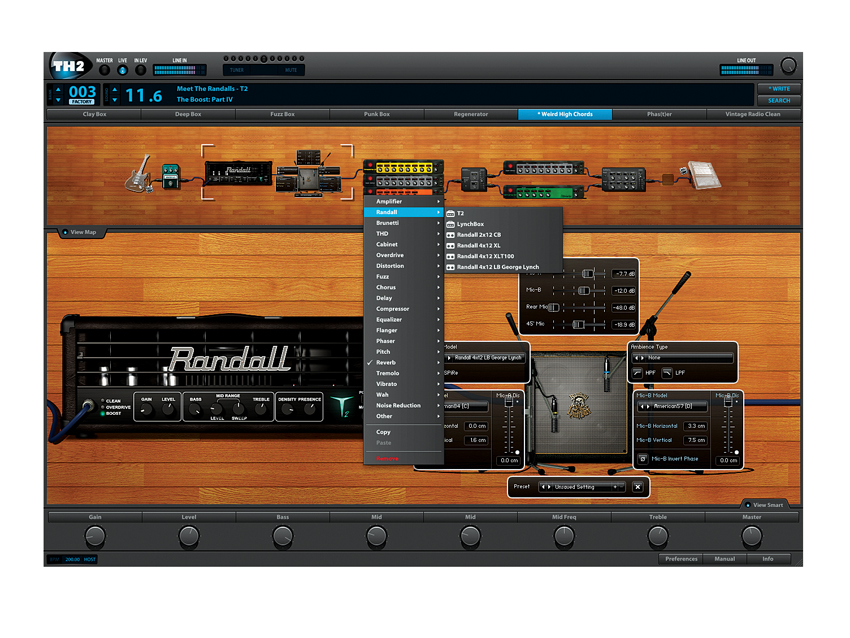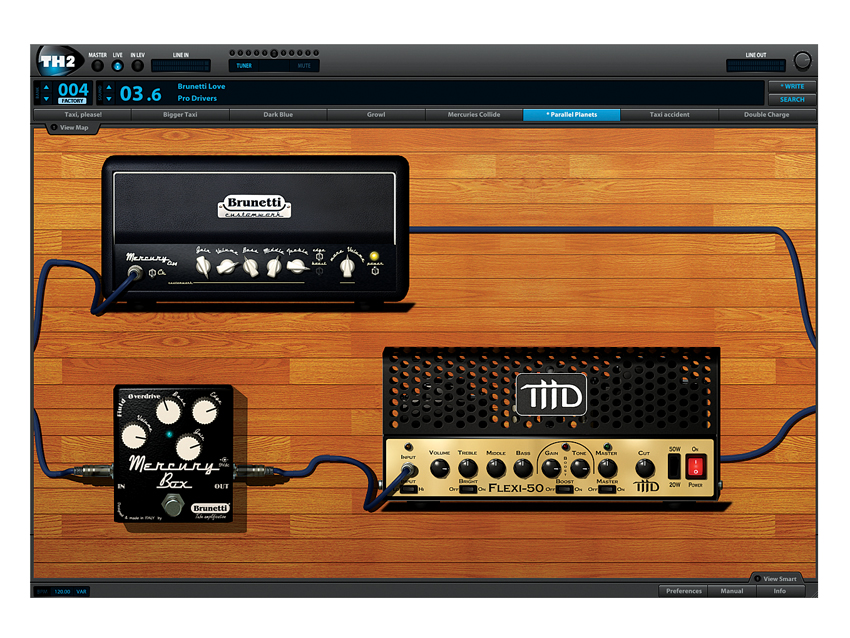MusicRadar Verdict
Overloud has brought TH2 up to current guitar amp sim standards, and in some respects exceeded them.
Pros
- +
Superb versatility. All tonal bases covered convincingly. Randall Lynch Box model is stunning. Extensive selection of effects. Convincing spring reverb.
Cons
- -
Cab sim is good but not great. Some GUI aspects could be improved. Peavey 5150 model still below par.
MusicRadar's got your back

Overloud TH2

Overloud TH2
Italian developer Overloud made a stunning debut with the TH1 software amp simulator, prompting us to brand it "a serious contender for best all-round guitar amp package". The tones on offer were impressive and expressive, coping particularly well with the challenging sounds of full-on rock and contemporary metal.
TH2 ups the ante by adding fully authorised modelling of Randall, Brunetti and THD amps, collectively providing 25 new amp models on top of the existing mob of unofficial imitations of Fender, Marshall, Mesa Boogie, Vox, Peavey and Soldano amps.
"Flicking through the presets reinforces the fact that TH2 falls into the bells/whistles/kitchen-sink bracket."
Anyone who's played through a real Brunetti or Randall amp will attest that they're among the finest-sounding valve amps on the market. If TH2's simulations live up to their real-life sound then this will be the main draw for both newcomers and upgraders alike.
Additionally, the new version includes a spring reverb (based on Overloud's SpringAge), a revised cabinet module (providing eight new Randall cabinets), a refreshed interface, and generally improved sound quality.
It must be said that the interface doesn't offer much improvement over TH1. We liked the resizeable 'gear room' design of the original, though, so we're not complaining too much. However, careless details like the names on the amp switches sometimes being too small to read are annoying.
Overloud and proud
Flicking through the factory presets reinforces the fact that TH2 falls very much into the infinite possibilities/bells/whistles/kitchen-sink bracket of guitar amp packages. It features numerous processing modules and effects, a mic/cabinet modeller and a parallel signal mixer for 'dual' tones.
The presets are good starting points, but you often need to tweak, tweak and tweak some more before getting into the right ball-park for a desired tone. This is frequently worth the effort, but you might want to skip straight to building a signal chain from scratch.
Want all the hottest music and gear news, reviews, deals, features and more, direct to your inbox? Sign up here.
TH1's dual morphable amp module is still available, with most amps having two or three channels to choose from, and the option to create a hybrid of any two using the SLR slider.
On top of the ten pre-existing amp models are two new efforts: Tumble ODS (a Dumble amp sim, we presume) and High Wattage (which has to be a Hiwatt model). These additions are decent, if not amazing, and we're still not impressed with the fizzy Peavey 5150 emulation.
Amp happy
The two Randall amps are presented as entirely separate modules, and firing up the Randall T2 amp with a vintage 4x12 cab was nothing short of an absolute delight. As soon as you move from the clean channel to the overdrive or boost, it's immediately obvious how well the valve-esque low-end growl required of authentic rock and metal tones has been captured - all the more pleasing because this is an area that many amp simulators struggle in.
Credible rock tones all the way from Van Halen's trademark brown sound through to the transparent rhythm tones of Angus Young and the low-end tightness, punch and definition of James Hetfield's crunch are within reach.
The Randall Lynch Box amp is perhaps even more impressive - and, being a modular amp itself, more flexible too. We then had the pleasure of checking out the Brunetti Mercury and R-Evo amps, as well as the THD Univalve and Flexi 50 amps, all likewise presented as individual modules.
These were no less impressive, each in their own unique way, but different beasts to the Randall models. Suffice to say, though, that if you're clamouring for standard tones ranging from analogue clean to gutsy, warm rock in the style of, say, Gilmour/Clapton through to Hendrix/Rhoads, then the Brunetti and THD models have it nailed.
By George, I think they've got it!
For many guitarists, authenticity in 'feel' and playing response is what software amp sims fail to adequately recreate. In this respect, the Randall Lynch Box amp emulation succeeds where so many others have failed, taking us to new heights of hard rock nirvana.
The real amp is a signature model for rock legend George Lynch. It's based around Randall's MTS modular system, which enables the player to change a preamp stage by literally yanking it out of the front of the amp and shoving in another.
The way TH2's Lynch Box emulation reacts when you dig into the strings, and the way the bottom end responds when you dampen and chug on the low E string, for example, reveals a highly realistic and commendable harmonic content. It's easy to nail the distinctive harmonic squeals on George Lynch's Wicked Sensation riff, and all with a thoroughly authentic tone.
Like the real amp, you can change preamp modules, and there are 13 emulated here. The 'Mr Scary' one (a Lynch signature MTS preamp) has to be heard - and felt - to be believed.
On top of this, there are five new effects modules, including two Brunetti overdrives, a Boss SD-1-alike, a looper and the AQTX spring reverb, which simply exudes sonic excellence.
Cabinet fever
Moving on, cabinet/mic modelling comprises two mixable mics, fully adjustable placement, room ambience options, polarity inversion and high-/low-pass filters. To see how TH2 stacks up against other offerings, we used the built-in impulse response loader to compare the software's flexible cab emulation to a third-party impulse response from RedWirez - namely the Marshall 1960a with G12M speakers.
Although the difference wasn't vast, we actually preferred the natural, authentic tones of the RedWirez impulse responses to most of those available from TH2. Still, this is a minor criticism.
While we've concentrated on TH2's additions, it's worth taking stock of the existing features such as the range of great effects - these cover noise gate, compression, chorus, flanger, phaser, pitch, tremolo, vibrato, wah-wah and more. Many of these work great on non-guitar sources when used on their own.
Another attractive feature is the fact that as well as the VST/AU/ RTAS plug-in, you get a standalone version too - something that not all competitors provide.
To conclude, TH2 puts Overloud's guitar amp sim firmly back on the map, making it yet another virtual rig you really must try. Now kitted out with the Lynch Box, TH2 becomes a serious contender for the meatiest, punchiest and most authentic valve emulation available in software form.
Now listen to our audio examples:
Clean Tone with Delay, Reverb and Chorus and similar sound for the solo part (Randall T2 amp)
Clean Tone with Delay, Reverb and Chorus with Driven Solo tone (Randall Lynch Box amp)
Brunetti Mercury Crunch with THD Flexi 50 very slightly driven
Rock riff using Randall T2 and ReSPiRe cabinet modelling
Computer Music magazine is the world’s best selling publication dedicated solely to making great music with your Mac or PC computer. Each issue it brings its lucky readers the best in cutting-edge tutorials, need-to-know, expert software reviews and even all the tools you actually need to make great music today, courtesy of our legendary CM Plugin Suite.
